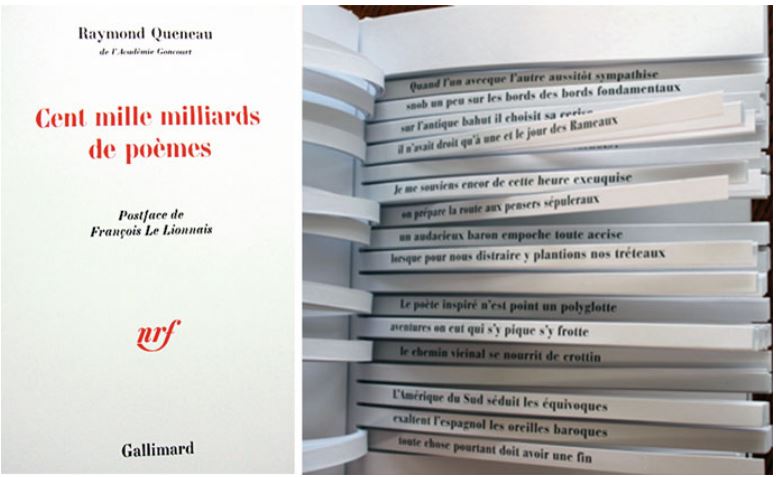A poem is a machine made of words.
William carlos williams
In 1961, Raymond Queneau, a co-founder of OuLiPo, the “Workshop of Potential Literature”, published a curious book with the perfectly literal title Cent mille milliards de poèms. It consisted of ten fourteen-line sonnets with an important twist. Each page was cut, spine to outer margin under each line. That is, the book was really a booklet of 140 slips that each contained one line of the poem. True to form, Queneau had even ensured that the rhyme sounds at the end of lines were the same, line for line, in each of all ten poems. As the title suggests, the implications were rather astounding. By turning not the pages but the slips different formally correct poems could be produced from each possible combination of lines. Even keeping the lines in the same order, as the spine compels (so that line 5 in one poem could only be replaced with line 5 from another), this implied 1014 (a hundred million million, or a hundred thousand billion) unique poems. That’s more poems than anyone could ever read, write, or imagine in a lifetime.*

In 1997, a French court ruled that it was illegal to publish the poem online. You can of course find it there anyway, but it’s interesting to read Wikipedia’s account (based on a 2001 article in the French magazine Multitudes.)
In 1997, a court decision outlawed the publication on the Internet of Raymond Queneau‘s Hundred Thousand Billion Poems, an interactive poem or sort of machine to produce poems.[8] The court decided that the son of Queneau and the Gallimard editions possessed an exclusive and moral right on this poem, thus outlawing any publication of it on the Internet and possibility for the reader to play Queneau’s interactive game of poem construction.[8]
“Copyright law in France”, Wikipedia
Espen Aarseth (1997, p. 10) has described it as a “sonnet machine”, a key example of what he called “ergodic literature,” from ergon-hodos (work-path), i.e., a text that requires “nontrivial effort” on the part of the reader to follow, a piece of writing that it takes work to read (p. see also Hayot and Wesp, 2004). The reader is faced, not with ten poems that can be read in or out of sequence by flipping the pages of a book in the ordinary way (a “trivial effort”, let’s say), but must actively choose between 10 slips of paper for each line, assembling a poem, and then making sense of the result.
One might argue — as Queneau’s son apparently did (see Vaver and Sirinelli, 2002, pp. 267-8) — that by removing this work of active reading — by having a machine effortlessly assemble a “random” poem from the available lines and presenting it seamlessly — violates the spirit of Queneau’s original work and therefore the moral rights of its original author (in particular, “the right to the integrity of the work”).
Queneau wrote ten poems and came up with a clever gimmick that turned them into a hundred thousand billion potential poems. He is the author of the original poems and the inventor of the gimmick. “A poem is a small (or large) machine made of words,” said William Carlos Williams; this one has ten small machines (in a sense Williams would recognize) that together make one that is larger (than he or any of us can imagine). One big robot to make a hundred thousand billion little bots! Is Queneau the writer of any but the ten original poems that the reader “works” upon, labors for? If not Queneau, who is? Are those poems written at all?
Let’s say we’ve got our work cut out for us!
____________
*In the spirit of OuLiPo we should probably do the math, right? (Queneau’s co-founder was the mathematician François Le Lionnais. See Toscano and Vaccaro 2020 for more.) Let’s say it takes at least five minutes to read and appreciate a sonnet with a even a modicum of seriousness. That means it would take five hundred thousand billion minutes to read “the whole book”. Divide by 60 and we get over eight thousand billion hours. Divide by 24 and we get a little over three hundred and thirty-three billion days. Divide by 365 and we could get it done in almost a billion years.